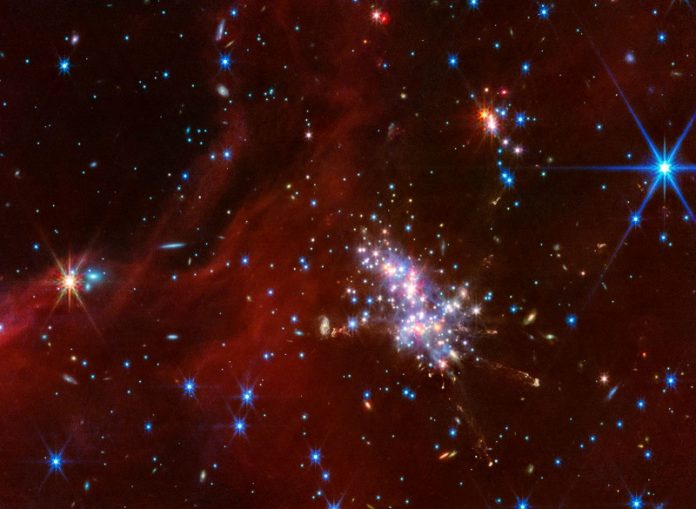
The Milky Way’s outer reaches are coming into view thanks to the JWST. Astronomers pointed the powerful space telescope to a region over 58,000 light-years away called the Extreme Outer Galaxy (EOG).
They found star clusters exhibiting extremely high rates of star formation.
The Milky Way’s EOG is defined as the part of the galaxy with a galactocentric radius of 18 kpc. That translates to almost 59,000 light-years, and for comparison, our Solar System is about 26,000 light-years from the galactic centre.
A team of astronomers used the JWST’s powerful NIRCam (Near-Infrared Camera) and MIRI (Mid-Infrared Instrument) to examine star formation in two specific regions of the EOG.
They’re molecular clouds named Digel Cloud 1 and Digel Cloud 2. They’re named after the astronomer Seth Digel, who discovered them in 1994.
The environment in the EOG is different than our Solar System’s neighbourhood; their metallicity and gas density are significantly lower.
Metallicity and gas density play huge roles in how Solar Systems evolve and how planets form.
The JWST is giving astronomers an opportunity to examine star formation in the EOG at the same level of detail they can closer to home.
The JWST’s supreme observing power allowed the researchers to examine the regions, and they found nebular structures, extremely young protostars, and outflow jets.
Their findings are in research published in the Astronomical Journal titled “Overview Results of JWST Observations of Star-forming Clusters in the Extreme Outer Galaxy.”
The lead author is Natsuko Izumi of Gifu University and the National Astronomical Observatory of Japan.
“In the past, we knew about these star forming regions but were not able to delve into their properties,” said Izumi. “The Webb data builds upon what we have incrementally gathered over the years from prior observations with different telescopes and observatories.
We can get very powerful and impressive images of these clouds with Webb. In the case of Digel Cloud 2, I did not expect to see such active star formation and spectacular jets.”
Astronomers have previously observed the region with the Subaru 8.2 meter telescope at the Mauna Kea Observatory in Hawaii. In 2008, some of the same astronomers used the Subaru to observe star formation in the clusters in Digel Cloud 2S.
In that research, the authors said that star-forming clusters were likely triggered by the same supernova.
But the Webb’s NIR is from 10 to 80 times more sensitive than the Subaru. “Accordingly, the mass detection limit reaches to about 0.01–0.05 solar masses, which is about 10 times better than the previous observations,” the researchers explain in their paper.
“We know from studying other nearby star-forming regions that as stars form during their early life phase, they start emitting jets of material at their poles,” said Mike Ressler, the study’s second author. Ressler is from NASA’s Jet Propulsion Laboratory and is the principal investigator of the observing program.
“What was fascinating and astounding to me from the Webb data is that there are multiple jets shooting out in all different directions from this cluster of stars. It’s a little bit like a firecracker, where you see things shooting this way and that.”
The astronomers observed nebular structures both in and around all the main clusters. “Notably, distinct nebular structures are identified within Cloud 2N and 2S,” they write. In Cloud 2N, the nebular structures are cliff-like and pillar-like and are similar to the ones found in star-forming regions closer to home, like in the JWST’s well-known ‘Cosmic Cliffs‘ and ‘Pillars of Creation‘ images.
These features are likely caused by intense ultraviolet radiation emitted by the nearby B-type star, MR 1, near Cloud 2N’s main structure.
This research provides an overview of the JWST’s observing effort in the EOG and the Digel Clouds. The authors say it’s just a starting point, and there’s lots more to discover. They want to determine the relative abundance of stars of different masses in the EOG and understand how the different environments shape that abundance.
“I’m interested in continuing to study how star formation is occurring in these regions. By combining data from different observatories and telescopes, we can examine each stage in the evolution process,” said Izumi.
“We also plan to investigate circumstellar disks within the Extreme Outer Galaxy. We still don’t know why their lifetimes are shorter than in star-forming regions much closer to us. And of course, I’d like to understand the kinematics of the jets we detected in Cloud 2S.”
Written by Evan Gough/Universe Today.



